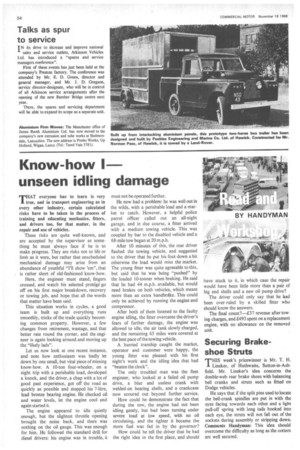Know-how I unseen idling damage
Page 56

If you've noticed an error in this article please click here to report it so we can fix it.
BY HANDYMAN
rr HAT everyone has to learn is very true, and in transport engineering as in every other industry, certain calculated risks have to be taken in the process of training and educating mechanics, fitters, and drivers too, for that matter, in the repair and use of vehicles.
These risks are quite well-known, and are accepted by the supervisor as something he must always face if he is to make progress. They are risks not to life or limb as it were, but rather that unscheduled mechanical damage may arise from an abundance of youthful "I'll show 'em", that is rather short of old-fashioned know-how.
Here, the engineer must stand, fingers crossed, and watch his selected protege go off on his first major breakdown, recovery or towing job, and hope that all the words that matter have been said.
This situation works in cycles, a good team is built up and everything runs smoothly, tricks of the trade quickly becoming common property. However, a few changes from retirement, wastage, and that better rate round the corner, and the engineer is again looking around and moving up the "likely lads".
Let us now look at one recent instance, and note how enthusiasm was badly let down by one small, but vital piece of missing know-how. A 10-ton four-wheeler, on a night trip with a perishable load, developed a knock, and the driver, a chap with a lot of good past experience, got off the road as quickly as possible and stopped his 7-litre, lead bronze bearing engine. He checked oil and water levels, let the engine cool and again started it.
The engine appeared to idle quietly enough, but the slightest throttle opening brought the noise back, and there was nothing on the oil gauge. This was enough for him. He followed the standard drill for diesel drivers: his engine was in trouble, it
must not be operated further.
He now had a problem: he was well out in the wilds, with a perishable load and a market to catch. However, a helpful police patrol officer called out an all-night garage, and in due course, a fitter arrived with a medium towing vehicle. This was coupled by bar to the disabled vehicle and a 68-mile tow began at 20 m.p.h. After 10 minutes of this, the rear driver flashed the towing vehicle, and suggested to the driver that he put his foot down a bit otherwise the load would miss the market. The young fitter was quite agreeable to this, but said that he was being "pushed" by the loaded 10-tonner when braking. He said that he had 44 m.p.h. available, but would need brakes on both vehicles, which meant more than an extra handbrdke. This could only be achieved by running the engine and compressor.
After both of them listened to the faulty engine idling, the fitter overcame the driver's fears of further damage, the engine was allowed to idle, the air tank slowly charged, and the remaining 65 miles were covered at the best pace of the towing vehicle.
A hurried tranship caught the market, operator and customer were happy, the young fitter was pleased with his first night's work and the idling idea that had "beaten the clock".
The only troubled man was the fleet engineer, who looked at a failed oil pump drive, a blue and useless crank with welded-on bearing shells, and a crankcase now scoured out beyond further service.
How could he demonstrate the fact that during the tow, the engine had not been idling gently, but had been turning under severe load at low speed, with no oil circulating, and the tighter it became the more fuel was fed in by the governor?
How could he tell the driver that he had the right idea in the first place, and should have stuck to it, in which case the repair would have been little more than a pair of big end shells and a new oil pump drive?
The driver could only say that he had been over-ruled by a skilled fitter who should know the answers.
The final count?—£37 revenue after towing charges, and E493 spent on a replacement engine, with no allowance on the removed unit.




































































































































